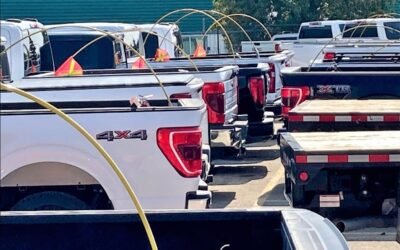Equipment Inspection Guide
Equipment inspection is a vital practice that ensures the safe and efficient operation of machinery, tools, devices, and systems across industries. This systematic process involves assessing equipment for operational integrity, safety, and overall condition. By closely examining equipment for wear, damage, or malfunction, organizations can identify potential hazards and make informed decisions about continued use or repair.
It involves evaluating components and mechanisms to identify deterioration, defects, or potential hazards that could compromise performance or pose risks to personnel, the environment, or infrastructure. These inspections enhance safety by proactively identifying hazards and faults, thus preventing accidents and injuries.
They also mitigate risks by addressing issues early, reducing breakdowns and operational disruptions. Not to mention, they ensure compliance with regulations, optimize performance, extend equipment lifespan, and facilitate preventive maintenance. In manufacturing, inspections maintain product quality, while also identifying environmental risks. Regular inspection data empowers informed decisions for repairs and upgrades, optimizing equipment performance.
Understanding and implementing equipment inspections is not only beneficial but also a responsibility that directly impacts the safety, productivity, and sustainability of operations. By thoroughly comprehending the significance of equipment inspections and integrating them into standard procedures, organizations demonstrate a commitment to creating a secure working environment. In fact, the act of understanding and applying equipment inspections is a strategic investment in the well-being of personnel and operational success.
What Is an Equipment Inspection Checklist?
An equipment inspection checklist serves as a systematic and organized tool for evaluating numerous components of machinery, aimed at guaranteeing the operational preparedness and safety of equipment prior to use. Frequently utilized by machine operators across a diverse range of industries — including warehousing, manufacturing, retail, and construction — this checklist is meticulously designed to safeguard the well-being of both equipment operators and the machinery itself. By methodically examining critical parts and systems, the checklist ensures that equipment functions optimally and adheres to safety standards, minimizing potential risks and promoting operational efficiency.
One of the key benefits of utilizing a heavy equipment inspection checklist is the prevention of workplace accidents. By systematically evaluating equipment components, operators can identify and address potential safety hazards or malfunctioning parts before they lead to accidents or injuries. Regularly checking equipment’s functionality and safety features helps safeguard employees from such accidents.
Additionally, an equipment inspection checklist contributes to cost savings. The cost of replacing heavy equipment is substantial, with new machinery ranging from tens of thousands to hundreds of thousands of dollars. By conducting thorough inspections, organizations can identify issues early on and address them with more affordable repairs before they escalate into major problems necessitating costly replacements. Detecting and addressing issues in their initial stages avoids the need for complete equipment replacement, thereby saving substantial financial resources.
Ultimately, a heavy equipment inspection checklist serves as a proactive measure to ensure the proper functionality and safety of machinery while providing tangible benefits such as accident prevention and cost-effective maintenance. This, in turn, aligns operations with the goals of protecting employees and optimizing operational efficiency.
How to Create an Inspection Checklist
To create an effective equipment inspection checklist, it’s essential to consider the specific requirements and safety considerations of the equipment being assessed. Begin by identifying key components and safety features that need scrutiny before operation. Include checks for potential hazards, wear and tear, fluid levels, and any equipment-specific concerns.
Regularly update the checklist based on equipment changes, industry regulations, and lessons learned from previous inspections. A well-designed checklist helps guide operators through a comprehensive assessment, as exemplified by the following types: Pre-Start Checklist, which ensures readiness by examining numerous aspects of equipment; Warm-Up Checklist, focusing on vital checks after initial operation; and Shutdown Checklist, streamlining end-of-shift preparations for the next day. Integrating these tailored checklists into a maintenance routine maximizes safety and efficiency.
Pre-Start Checklist
Before starting heavy equipment, a pre-start checklist ensures operational safety. This comprehensive checklist ensures equipment is safe and ready for operation, preventing accidents and maintaining performance. It includes checks for:
- Proper parking
- Testing seat belt functionality
- Inspecting parts for wear
- Checking for leaks
- Verifying fluid levels
- Examining undercarriage components
- Assessing the engine and its components
- Inspecting tires, rims, valves, belts, hoses, and more
Warm-Up Checklist
After heavy equipment has been running for five to 10 minutes, a warm-up checklist focuses on critical checks that ensure the equipment is running optimally during its operation phase. This includes:
- Confirming alarms are functional
- Testing the horn
- Inspecting and possible cleaning or replacing the air filter
- Ensuring all lights are operational (signal, brake, headlights, etc.)
- Assessing the hydraulic system and lines for irregular noises
- Checking fluid levels for hydraulic oil, engine steering, coolant, power terrain, and swing drives
Shutdown Checklist
At the end of a shift, the shutdown checklist aids in preparing the equipment for the next day. It streamlines the pre-start checks, ensuring a smooth and safe start-up and operation the next time the equipment is used. This checklist involves:
- Filling the fuel tank to capacity
- Securing the fuel tank cap
- Allowing the engine to idle for five minutes before shutting down
- Safely parking the equipment in a debris-free area
Incorporating these different types of equipment inspection checklists into a well-structured routine maintenance protocol helps maintain the safety, efficiency, and longevity of heavy equipment while avoiding costly repairs. By systematically integrating pre-start, warm-up, and shutdown checklists into the maintenance regimen, organizations establish a comprehensive framework that addresses every operational phase of the equipment.
This proactive approach mitigates the potential for accidents by identifying and rectifying issues before they escalate into safety hazards.
How to Conduct an Equipment Inspection
When conducting an equipment inspection, an organization should adopt a systematic approach that comprises two distinct stages: observation and inspection principles.
Observation
Before initiating the inspection process, it’s crucial to establish a well-defined inspection route and thoroughly review the objectives of the inspection. This initial phase sets the stage for a comprehensive assessment by ensuring that key areas and equipment components are covered. In this preliminary stage, the primary focus lies on observation, which involves closely scrutinizing the equipment, work environment, and the actions of personnel.
This active observation aims to identify potential hazards, poor work practices, and unsafe behaviors that could compromise safety or lead to equipment issues. Notable aspects to monitor encompass a wide range of factors, including unauthorized use of machinery or tools, the presence of defective equipment, instances of safety guards being removed or rendered ineffective, instances of improper lifting techniques, and the creation of conditions that may pose risks.
The objective during this phase is to meticulously pinpoint areas where deviations from safe practices occur, allowing for targeted interventions and corrective actions to be applied during subsequent stages of the inspection process.
Inspection
Once observations are made and poor practices identified, the organization must proceed with the core inspection process while adhering to the following principles:
- Lockout and Shutdown: Before commencing the inspection, ensure that any hazardous equipment or items are locked out and shut down to prevent inadvertent activation during the examination.
- Operator Demonstration: Seek permission from equipment operators for a demonstration before operating machinery. Familiarize yourself with equipment controls, functionality, and safety features.
- Methodical and Thorough Inspection: Inspect the equipment systematically and thoroughly, aiming to identify potential hazards, damages, or malfunctions. Examine components, parts, and systems meticulously to ensure a comprehensive assessment.
- Precise Documentation: Document each observed hazard, its exact location, and any findings during the inspection. Clear, accurate records are vital for future reference, communication, and corrective actions.
- Consider Organizational Factors: Analyze how work processes, organization, and environmental factors impact safety. This broader perspective helps uncover underlying causes of safety concerns.
- Collaboration and Decision-Making: Engage the inspection team in discussions to collectively assess hazards and determine suitable corrective actions. The team’s diverse input enhances the effectiveness of the inspection process.
- Thorough Examination: Rely on more than just your senses. Properly check and examine equipment, components, and settings to ensure a hazard-free environment. When descriptions or sketches fall short, consider taking photographs to capture specific situations accurately.
By adhering to these observation and inspection principles, organizations can conduct equipment inspections in a thorough, methodical, and safety-focused manner. This structured approach not only ensures that potential hazards and safety concerns are systematically identified but also lays the foundation for immediate corrective actions.
What Are the Benefits of Equipment Inspection?
Equipment inspection is a critical practice that offers a multitude of advantages, no matter what industry you are in or what type of equipment you use. By systematically evaluating machinery, tools, and systems, organizations can ensure enhanced reliability, improved output quality, extended machine life, increased employee safety, and reduced maintenance costs. These benefits collectively contribute to operational efficiency, cost-effectiveness, and the overall well-being of both the workforce and equipment.
Increased Reliability
Equipment inspections contribute to increased reliability by identifying and addressing potential issues before they escalate into major problems. Regular inspections help detect wear and tear, faulty components, and emerging problems, allowing organizations to take corrective actions promptly. This proactive approach minimizes unexpected breakdowns, reduces downtime, and ensures that equipment operates consistently, boosting overall reliability and operational efficiency.
Higher Output Quality
Effective equipment inspections lead to higher output quality by maintaining the functionality and performance of machinery. When equipment is in optimal condition, it operates within specified tolerances, producing consistent and accurate results. Inspections ensure that all components are functioning as intended, reducing the likelihood of defects, errors, or deviations in the output, thus improving product quality.
Greater Insights into Maintenance and Repairs
Equipment inspections provide valuable insights into maintenance and repairs by revealing patterns of wear, identifying recurring issues, and indicating potential points of failure. This information helps organizations plan maintenance activities more strategically, addressing concerns before they cause significant disruptions. With regular inspections, maintenance teams can create well-informed maintenance schedules, optimize resource allocation, and efficiently allocate resources for repairs.
Longer Machine Life
Routine equipment inspections contribute to longer machine life by detecting and addressing issues that could lead to premature wear and tear. By identifying and rectifying problems early, inspections prevent minor concerns from escalating into major breakdowns. This extends the operational lifespan of machinery, delaying the need for costly replacements and maximizing the return on investment for equipment.
Increased Employee Safety
Equipment inspections directly enhance employee safety by identifying potential hazards and ensuring that safety features are functional. Inspections uncover issues such as faulty safety guards, malfunctioning emergency stop buttons, or other safety-related concerns. Addressing these problems promptly creates a safer work environment, reducing the risk of accidents and injuries for workers operating the machinery.
Reduced Maintenance Costs
Well-executed equipment inspections lead to reduced maintenance costs by addressing issues before they become major problems. Timely identification of wear, damage, or malfunctioning parts allows for less costly repairs compared to extensive overhauls or equipment replacements. Preventative maintenance based on inspection findings also helps avoid costly emergency repairs, contributing to overall cost savings.
Reliable Equipment Inspection from Summit Fleet
Regular equipment inspections are of paramount importance as they ensure the safe and efficient operation of machinery, tools, devices, and systems across industries. By systematically assessing equipment for damage or malfunction, organizations can identify potential hazards and make informed decisions about continued use or necessary repairs and replacements.
This practice enhances safety by proactively identifying faults, preventing accidents, and mitigating risks. Not only that, but equipment inspections also optimize performance, extend lifespan, and facilitate preventive maintenance, ultimately contributing to operational efficiency, cost-effectiveness, and the overall well-being of both personnel and equipment.
At Summit Fleet, safety is at the core of our operations, and we take equipment inspections incredibly seriously for every vehicle in our fleet. We understand that our renters’ peace of mind is paramount, and that’s why we’ve built a comprehensive and meticulous inspection process to ensure that our fleet vehicles are in top-notch condition before they hit the road.
Our commitment to safety means that our renters can trust in the reliability and performance of our vehicles, knowing that potential issues are identified and resolved proactively through regular inspections. With Summit Fleet, you can focus on your journey without worry, knowing that you’re driving in vehicles that have undergone rigorous scrutiny to meet the highest safety standards.
Ready to get started? Get your rate today.






